A Case Study of Behaviour and Performance of Confined or Pastured Cows During the Dry Period
Abstract
:Simple Summary
Abstract
1. Introduction
2. Materials and Methods
2.1. Animals and Management
2.2. Feeding Management
2.3. Behavioural Assessment
2.4. Intramammary Infections
2.5. Descriptive Measurements
2.5.1. Cow-Based Assessments
2.5.2. Physiological Measurements
2.5.3. Cow Health
2.6. Statistical Analyses
3. Results
3.1. Descriptive Measures
3.2. Behavioural Assessment
3.3. Intramammary Infections
4. Discussion
4.1. Behavioural Assessment
4.2. Intramammary Infections
4.3. Study Limitations
5. Conclusions
Supplementary Materials
Acknowledgments
Author Contributions
Conflicts of Interest
References
- USDA. Dairy 2007, Part II: Changes in the U.S. Dairy Cattle Industry, 1991–2007; USDA-APHIS-VS, CEAH: Fort Collins, CO, USA, 2008. [Google Scholar]
- USDA. Dairy Cattle Management Practices in the United States, Dairy 2014; USDA-APHIS-VS, CEAH: Fort Collins, CO, USA, 2016. [Google Scholar]
- USDA. Facility Characteristics and Cow Comfort on U.S. Dairy Operations, 2007; USDA-APHIS-VS, CEAH: Fort Collins, CO, USA, 2010. [Google Scholar]
- Fontaneli, R.S.; Sollenberger, L.E.; Littell, R.C.; Staples, C.R. Performance of lactating dairy cows managed on pasture-based or in freestall barn-feeding systems. J. Dairy Sci. 2005, 88, 1264–1276. [Google Scholar] [CrossRef]
- Bargo, F.; Muller, L.D.; Delahoy, J.E.; Cassidy, T.W. Performance of high producing dairy cows with three different feeding systems combining pasture and total mixed rations. J. Dairy Sci. 2002, 85, 2948–2963. [Google Scholar] [CrossRef]
- Hernandez-Mendo, O.; von Keyserlingk, M.A.G.; Veira, D.M.; Weary, D.M. Effects of pasture on lameness in dairy cows. J. Dairy Sci. 2007, 90, 1209–1214. [Google Scholar] [CrossRef]
- Washburn, S.P.; White, S.L.; Green, J.T., Jr.; Benson, G.A. Reproduction, mastitis, and body condition of seasonally calved holstein and jersey cows in confinement or pasture systems. J. Dairy Sci. 2002, 85, 105–111. [Google Scholar] [CrossRef]
- Olmos, G.; Boyle, L.; Hanlon, A.; Patton, J.; Murphy, J.J.; Mee, J.F. Hoof disorders, locomotion ability and lying times of cubicle-housed compared to pasture-based dairy cows. Livest. Sci. 2009, 125, 199–207. [Google Scholar] [CrossRef]
- Legrand, A.L.; von Keyserlingk, M.A.G.; Weary, D.M. Preference and usage of pasture versus free-stall housing by lactating dairy cattle. J. Dairy Sci. 2009, 92, 3651–3658. [Google Scholar] [CrossRef] [PubMed]
- Lidfors, L. The use of getting up and lying down movements in the evaluation of cattle environments. Vet. Res. Commun. 1989, 13, 307–324. [Google Scholar] [CrossRef] [PubMed]
- Chapinal, N.; Goldhawk, C.; de Passillé, A.M.; von Keyserlingk, M.A.G.; Weary, D.M.; Rushen, J. Overnight access to pasture does not reduce milk production or feed intake in dairy cattle. Livest. Sci. 2010, 129, 104–110. [Google Scholar] [CrossRef]
- Goldberg, J.J.; Wildman, E.E.; Pankey, J.W.; Kunkel, J.R.; Howard, D.B.; Murphy, B.M. The influence of intensively managed rotational grazing, traditional continuous grazing, and confinement housing on bulk tank milk quality and udder health. J. Dairy Sci. 1992, 75, 96–104. [Google Scholar] [CrossRef]
- Costa, E.O.; Ribeiro, A.R.; Watanabe, E.T.; Melville, P.A. Infectious bovine mastitis caused by environmental organisms. J. Vet. Med. B 1998, 45, 65. [Google Scholar] [CrossRef]
- Bradley, A.J.; Green, M.J. A study of the incidence and significance of intramammary enterobacterial infections acquired during the dry period. J. Dairy Sci. 2000, 83, 1957–1965. [Google Scholar] [CrossRef]
- Oliver, S.P.; Mitchell, B.A. Susceptibility of bovine mammary gland to infections during the dry period. J. Dairy Sci. 1983, 66, 1162–1166. [Google Scholar] [CrossRef]
- Neave, F.K.; Dodd, F.H.; Henriques, E. Udder infections in the dry period. J. Dairy Res. 1950, 17, 37–49. [Google Scholar] [CrossRef]
- Green, M.J.; Green, L.E.; Medley, G.F.; Schukken, Y.H.; Bradley, A.J. Influence of dry period bacterial intramammary infection on clinical mastitis in dairy cows. J. Dairy Sci. 2002, 85, 2589–2599. [Google Scholar] [CrossRef]
- McIntosh, D.W.; Bates, G.E.; Keyser, P.D.; Allen, F.L.; Harper, C.A.; Waller, J.C.; Birckhead, J.L.; Backus, W.M. Forage harvest timing impact on biomass quality from native warm-season grass mixtures. Agron. J. 2016. [Google Scholar] [CrossRef]
- Endres, M.I.; Barberg, A.E. Behavior of dairy cows in an alternative bedded-pack housing system. J. Dairy Sci. 2007, 90, 4192–4200. [Google Scholar] [CrossRef] [PubMed]
- Collings, L.K.M.; Weary, D.M.; Chapinal, N.; von Keyserlingk, M.A.G. Temporal feed restriction and overstocking increase competition for feed by dairy cattle. J. Dairy Sci. 2011, 94, 5480–5486. [Google Scholar] [CrossRef] [PubMed]
- DeVries, T.J.; von Keyserlingk, M.A.G.; Weary, D.M. Effect of feeding space on the inter-cow distance, aggression, and feeding behavior of free-stall housed lactating dairy cows. J. Dairy Sci. 2004, 87, 1432–1438. [Google Scholar] [CrossRef]
- Smith, T.R.; Chapa, A.; Willard, S.; Herndon, C., Jr.; Williams, R.J.; Crouch, J.; Riley, T.; Pogue, D. Evaporative tunnel cooling of dairy cows in the southeast. I: Effect on body temperature and respiration rate. J. Dairy Sci. 2006, 89, 3904–3914. [Google Scholar] [PubMed]
- Collier, R.J.; Doelger, S.G.; Head, H.H.; Thatcher, W.W.; Wilcox, C.J. Effects of heat stress during pregnancy on maternal hormone concentrations, calf birth weight and postpartum milk yield of holstein cows. J. Anim. Sci. 1982, 54, 309–319. [Google Scholar] [PubMed]
- Schütz, K.E.; Rogers, A.R.; Poulouin, Y.A.; Cox, N.R.; Tucker, C.B. The amount of shade influences the behavior and physiology of dairy cattle. J. Dairy Sci. 2010, 93, 125–133. [Google Scholar]
- Legrand, A.; Schütz, K.E.; Tucker, C.B. Using water to cool cattle: Behavioral and physiological changes associated with voluntary use of cow showers. J. Dairy Sci. 2011, 94, 3376–3386. [Google Scholar] [CrossRef] [PubMed]
- Barkema, H.W.; Deluyker, H.A.; Schukken, Y.H.; Lam, T.J.G.M. Quarter-milk somatic cell count at calving and at the first six milkings after calving. Prev. Vet. Med. 1999, 38, 1–9. [Google Scholar] [CrossRef]
- Reneau, J.K.; Seykora, A.J.; Heins, B.J.; Endres, M.I.; Farnsworth, R.J.; Bey, R.F. Association between hygiene scores and somatic cell scores in dairy cattle. J. Am. Vet. Med. Assoc. 2005, 227, 1297–1301. [Google Scholar] [CrossRef] [PubMed]
- Flower, F.C.; Weary, D.M. Effect of hoof pathologies on subjective assessments of dairy cow gait. J. Dairy Sci. 2006, 89, 139–146. [Google Scholar] [CrossRef]
- Wildman, E.E.; Jones, G.M.; Wagner, P.E.; Boman, R.L.; Troutt, H.F., Jr.; Lesch, T.N. A dairy cow body condition scoring system and its relationship to selected production characteristics. J. Dairy Sci. 1982, 65, 495–501. [Google Scholar] [CrossRef]
- Iwersen, M.; Falkenberg, U.; Voigtsberger, R.; Forderung, D.; Heuwieser, W. Evaluation of an electronic cowside test to detect subclinical ketosis in dairy cows. J. Dairy Sci. 2009, 92, 2618–2624. [Google Scholar] [CrossRef] [PubMed]
- Miller, K.; Wood-Gush, D.G.M. Some effects of housing on the social behaviour of dairy cows. Anim. Prod. 1991, 53, 271–278. [Google Scholar] [CrossRef]
- Metz, J.H.M. The reaction of cows to a short-term deprivation of lying. Appl. Anim. Behav. Sci. 1985, 13, 301–307. [Google Scholar] [CrossRef]
- Munksgaard, L.; Jensen, M.B.; Pedersen, L.J.; Hansen, S.W.; Matthews, L. Quantifying behavioural priorities—Effects of time constraints on behaviour of dairy cows, bos taurus. Appl. Anim. Behav. Sci. 2005, 92, 3–14. [Google Scholar] [CrossRef]
- Davidson, J.A.; Beede, D.K. Exercise training of late-pregnant and nonpregnant dairy cows affects physical fitness and acid-base homeostasis. J. Dairy Sci. 2009, 92, 548–562. [Google Scholar] [CrossRef] [PubMed]
- Kadzere, C.T.; Murphy, M.R.; Silanikove, N.; Maltz, E. Heat stress in lactating dairy cows: A review. Livest. Prod. Sci. 2002, 77, 59–91. [Google Scholar] [CrossRef]
- Lemerle, C.; Goddard, M.E. Assessment of heat stress in dairy cattle in papua new guinea. Trop. Anim. Health Prod. 1986, 18, 232–242. [Google Scholar] [CrossRef] [PubMed]
- Adin, G.; Gelman, A.; Solomon, R.; Flamenbaum, I.; Nikbachat, M.; Yosef, E.; Zenou, A.; Shamay, A.; Feuermann, Y.; Mabjeesh, S.J.; et al. Effects of cooling dry cows under heat load conditions on mammary gland enzymatic activity, intake of food and water, and performance during the dry period and after parturition. Livest. Sci. 2009, 124, 189–195. [Google Scholar] [CrossRef]
- Avendaño-Reyes, L.; Alvarez-Valenzuela, F.D.; Correa-Calderón, A.; Saucedo-Quintero, J.S.; Robinson, P.H.; Fadel, J.G. Effect of cooling holstein cows during the dry period on postpartum performance under heat stress conditions. Livest. Sci. 2006, 105, 198–206. [Google Scholar]
- Endres, M.I.; DeVries, T.J.; von Keyserlingk, M.A.G.; Weary, D.M. Short communication: Effect of feed barrier design on the behavior of loose-housed lactating dairy cows. J. Dairy Sci. 2005, 88, 2377–2380. [Google Scholar] [CrossRef]
- Compton, C.W.R.; Heuer, C.; Parker, K.; McDougall, S. Risk factors for peripartum mastitis in pasture-grazed dairy heifers. J. Dairy Sci. 2007, 90, 4171–4180. [Google Scholar] [CrossRef] [PubMed]
- Waage, S.; Sviland, S.; Ødegaard, S.A. Identification of risk factors for clinical mastitis in dairy heifers. J. Dairy Sci. 1998, 81, 1275–1284. [Google Scholar] [CrossRef]
- Bendixen, P.H.; Vilson, B.; Ekesbo, I.; Åstrand, D.B. Disease frequencies of tied zero-grazing dairy cows and of dairy cows on pasture during summer and tied during winter. Prev. Vet. Med. 1986, 4, 291–306. [Google Scholar] [CrossRef]
- Gibbons, J.M.; Lawrence, A.B.; Haskell, M.J. Consistency of aggressive feeding behaviour in dairy cows. Appl. Anim. Behav. Sci. 2009, 121, 1–7. [Google Scholar] [CrossRef]
- Schirmann, K.; Chapinal, N.; Weary, D.M.; Heuwieser, W.; von Keyserlingk, M.A.G. Short-term effects of regrouping on behavior of prepartum dairy cows. J. Dairy Sci. 2011, 94, 2312–2319. [Google Scholar] [CrossRef] [PubMed]
- Val-Laillet, D.; Passillé, A.M.D.; Rushen, J.; von Keyserlingk, M.A.G. The concept of social dominance and the social distribution of feeding-related displacements between cows. Appl. Anim. Behav. Sci. 2008, 111, 158–172. [Google Scholar] [CrossRef]
- Schütz, K.E.; Rogers, A.R.; Cox, N.R.; Webster, J.R.; Tucker, C.B. Dairy cattle prefer shade over sprinklers: Effects on behavior and physiology. J. Dairy Sci. 2011, 94, 273–283. [Google Scholar]
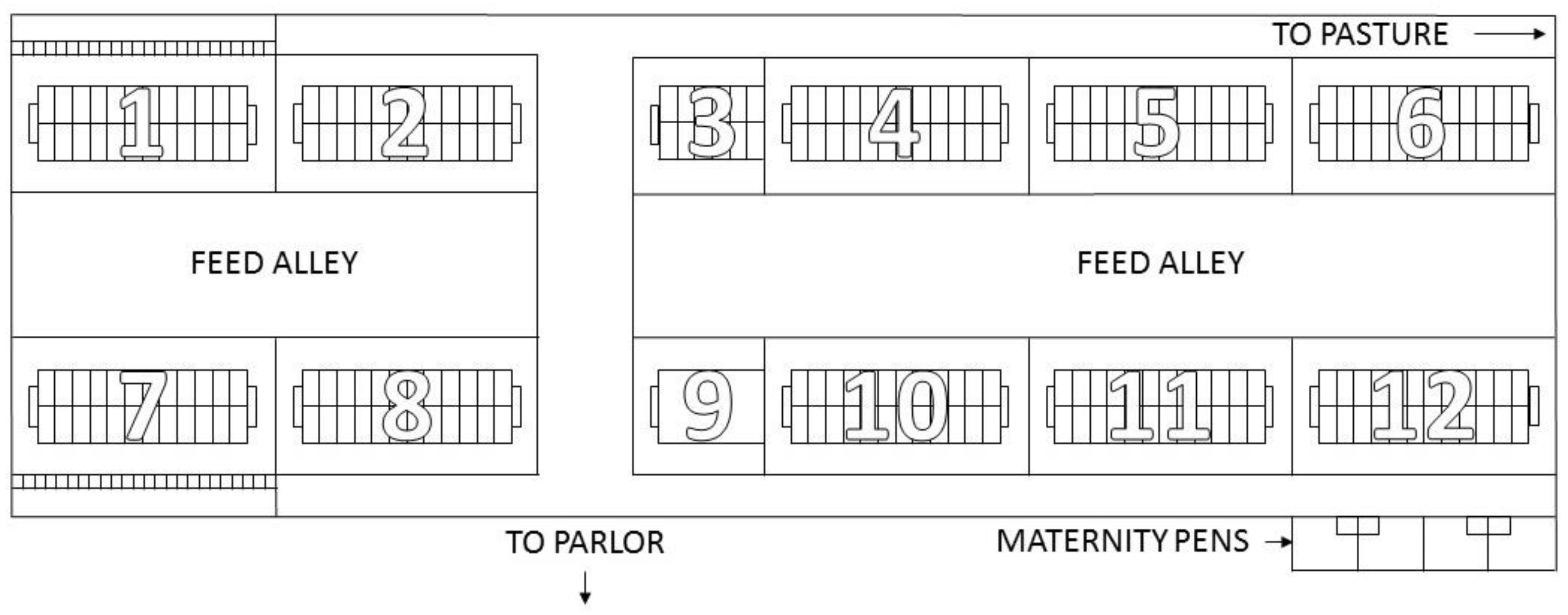
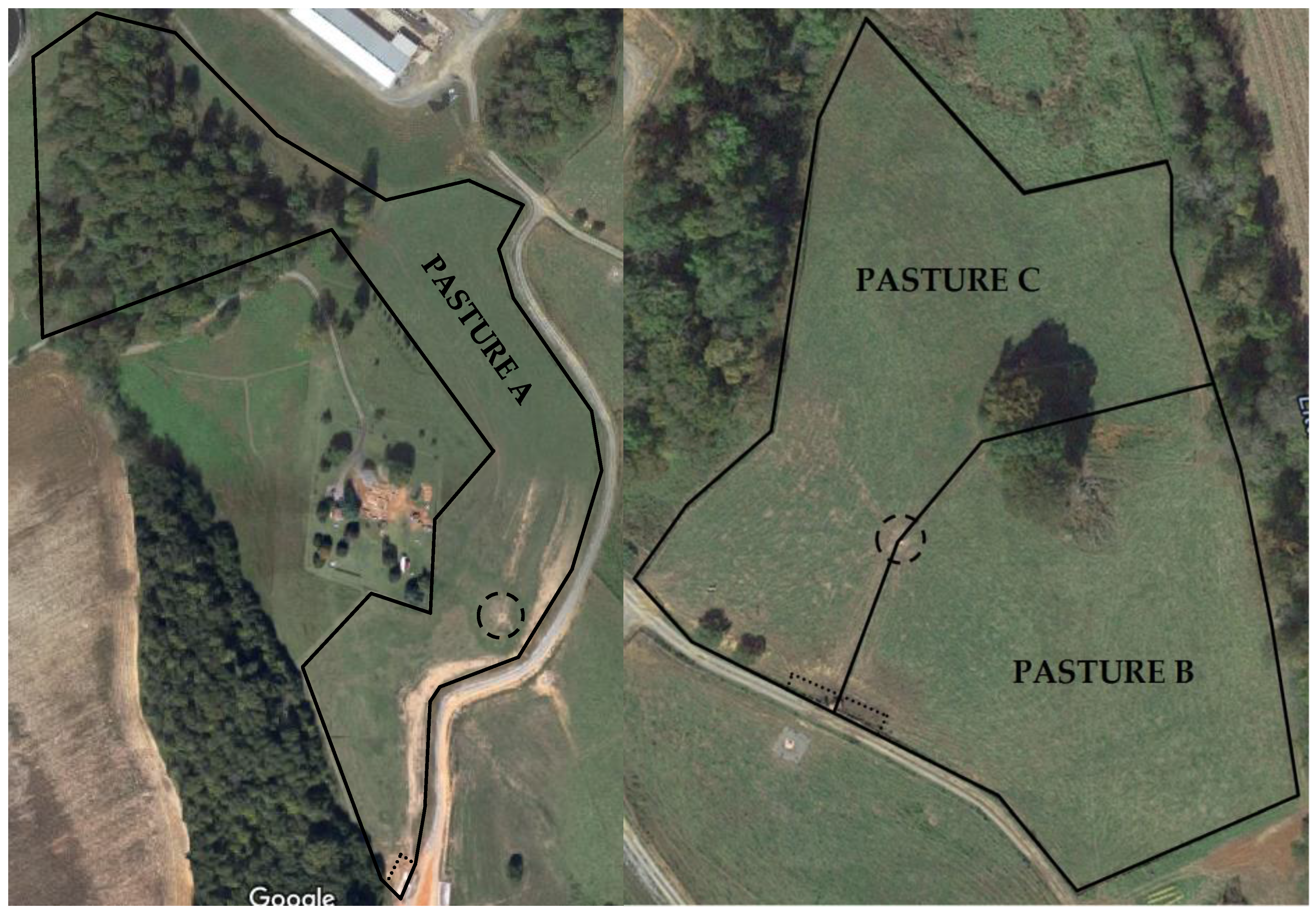
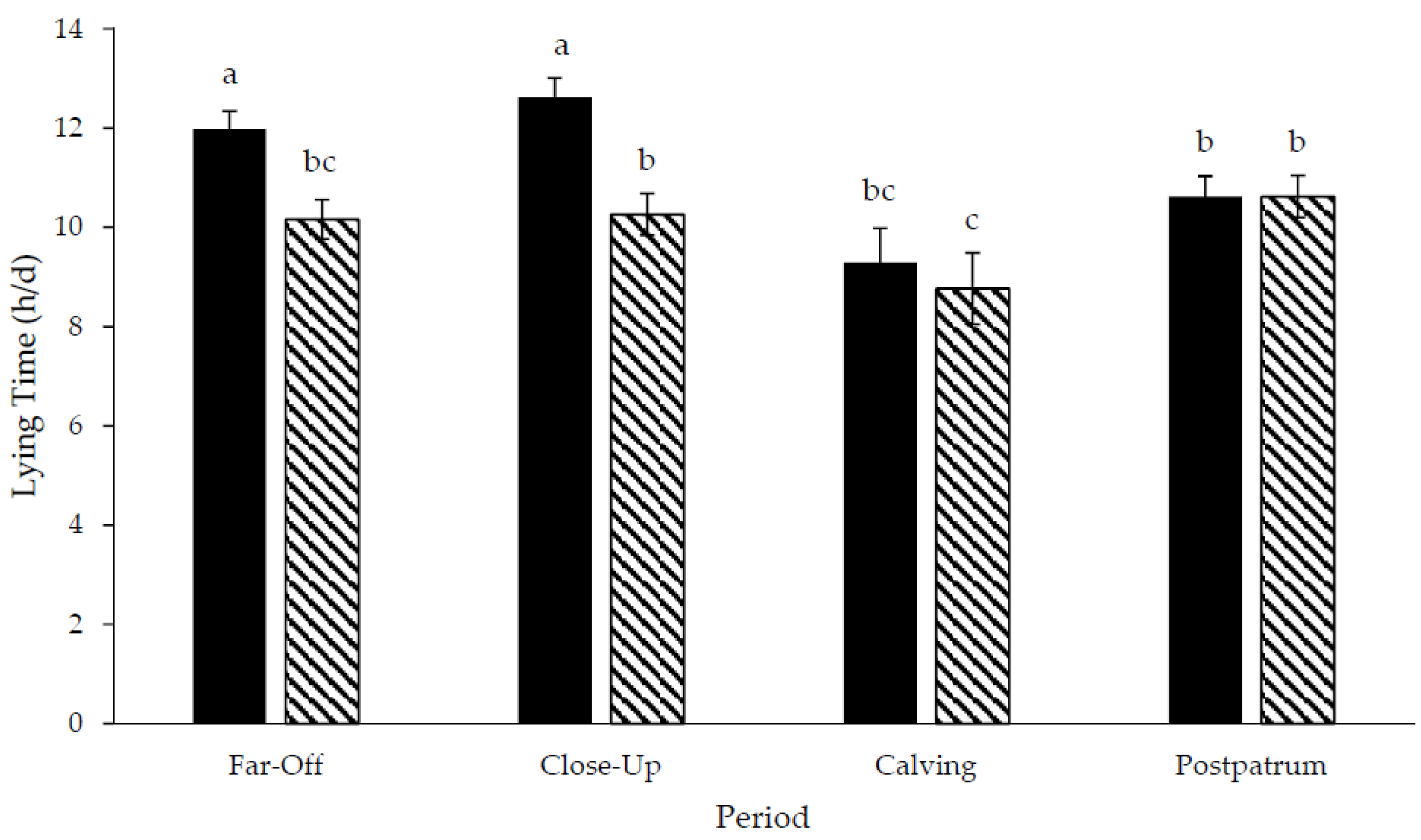
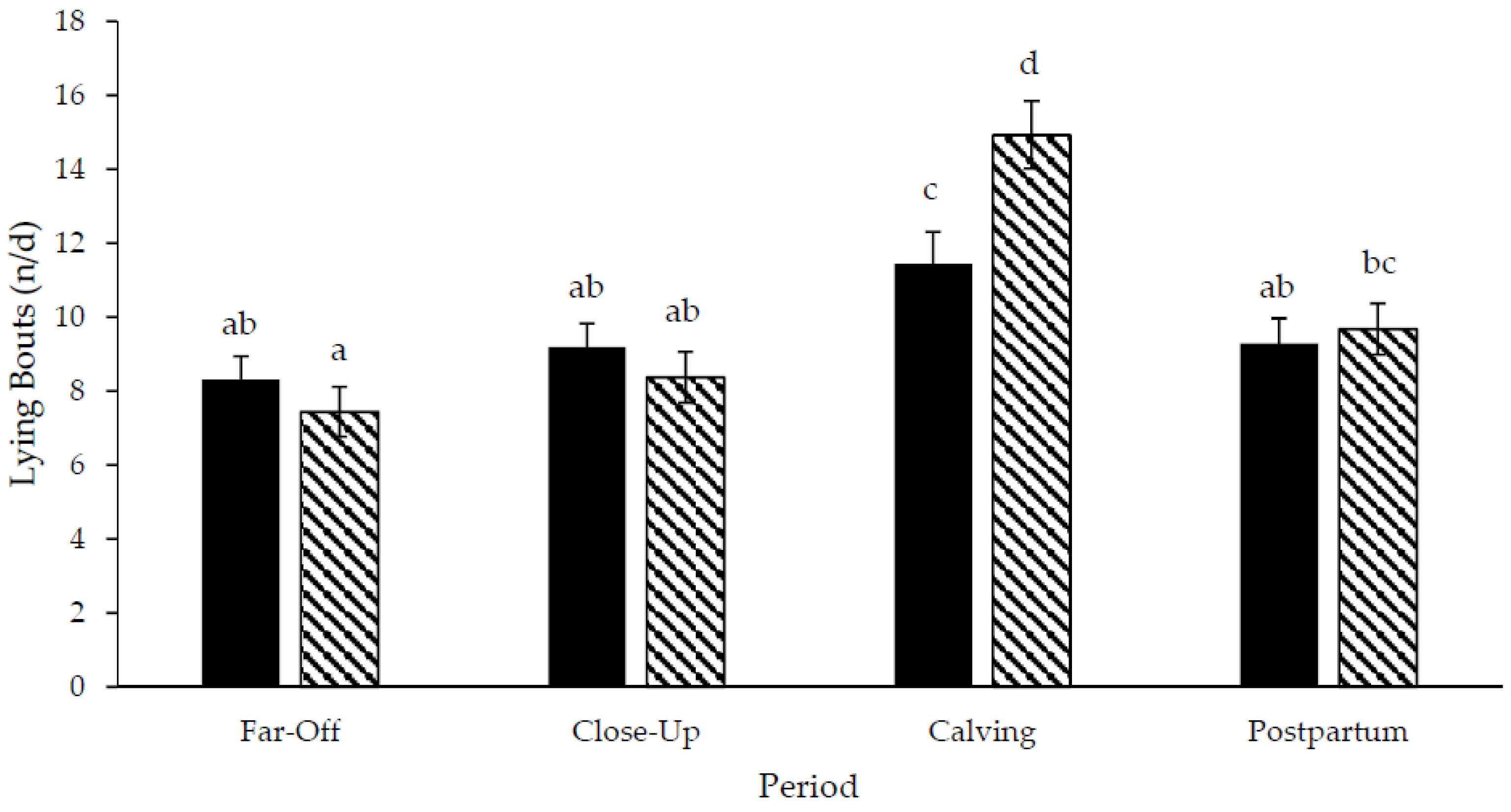
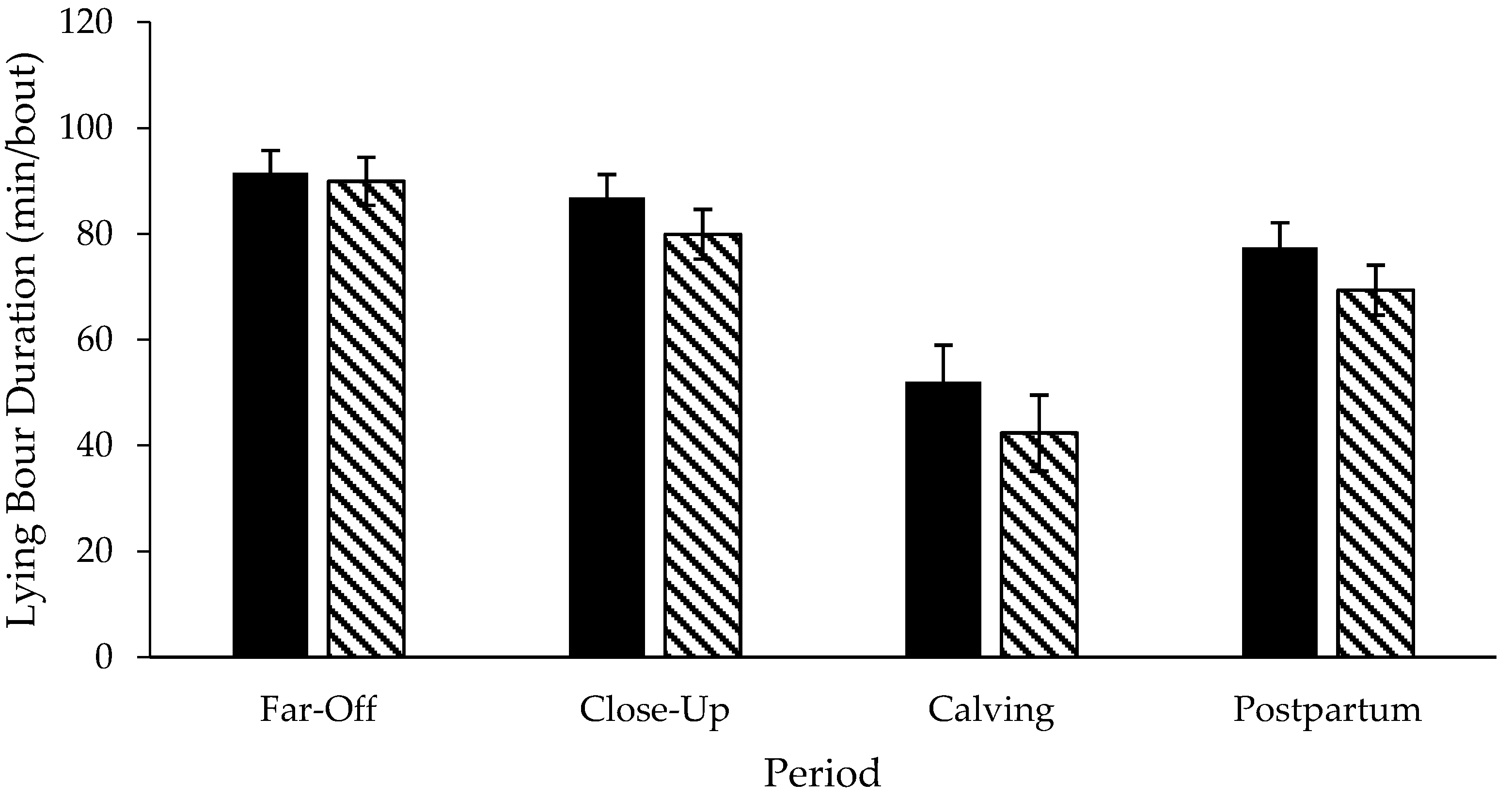
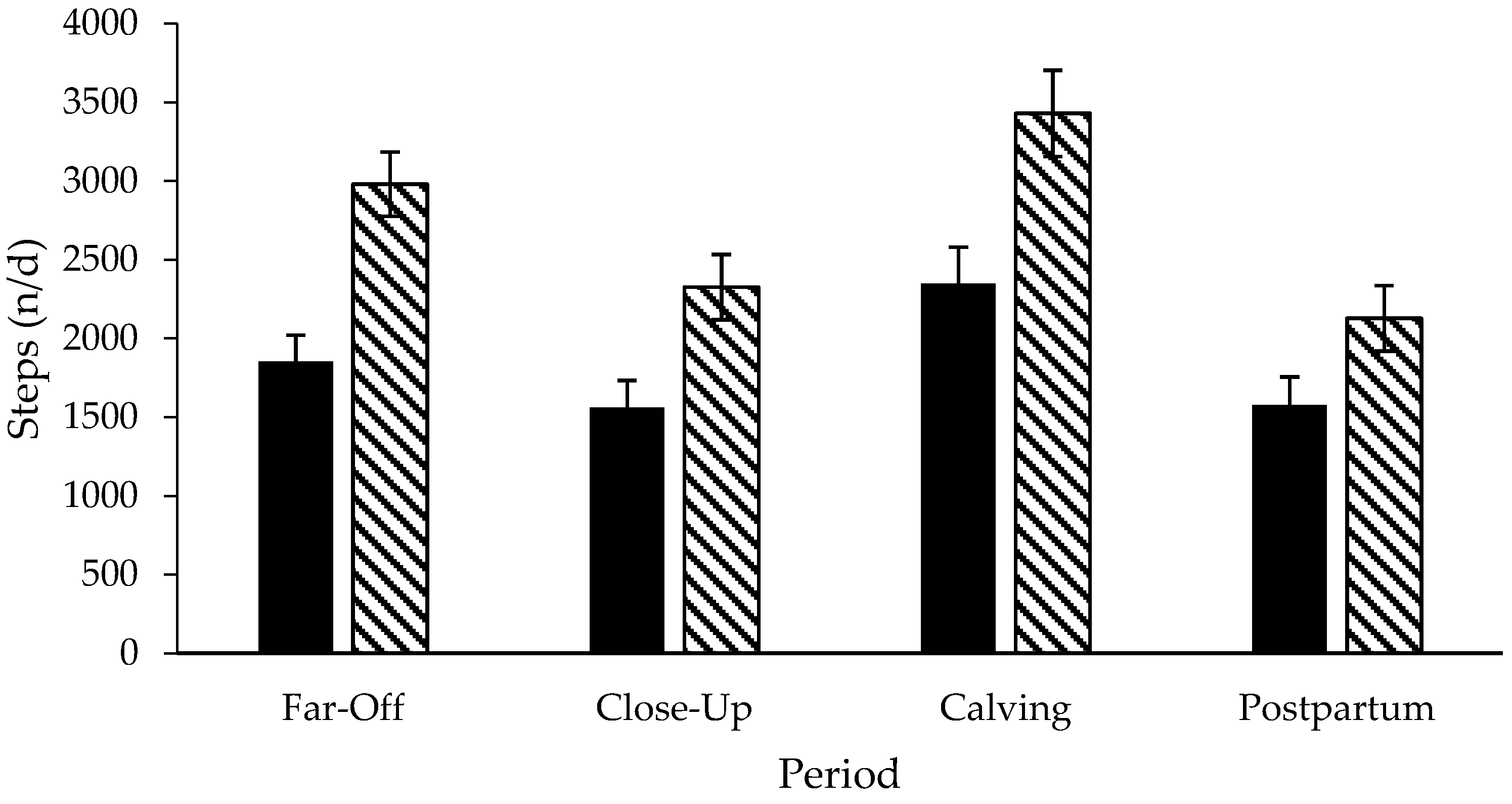


| Feed | Pen 1 | DM, % | CP, % | ADF, % | aNDF, % | Ca, % | P, % | K, % | Mg, % | Crude Fat, % | Lignin, % | Ash, % | TDN, % | NEL, Mcal/lb | NEM, Mcal/lb | NEG, Mcal/lb |
|---|---|---|---|---|---|---|---|---|---|---|---|---|---|---|---|---|
| Grass | A | 25.1 | 14.2 | 44.1 | 76.3 | 0.58 | 0.26 | 1.34 | 0.44 | 2.17 | 5.01 | 10.5 | 64 | 0.66 | 0.62 | 0.33 |
| Hay | A | 90.6 | 11.2 | 44.8 | 73.2 | 0.45 | 0.26 | 2.28 | 0.34 | 1.76 | 4.48 | 9.90 | 62 | 0.64 | 0.59 | 0.31 |
| Grass | B | 26.0 | 15.1 | 40.9 | 72.0 | 0.60 | 0.26 | 1.57 | 0.41 | 2.40 | 3.98 | 9.51 | 67 | 0.69 | 0.67 | 0.38 |
| Hay | B/C | 91.2 | 11.7 | 43.2 | 72.0 | 0.51 | 0.26 | 2.10 | 0.34 | 2.00 | 4.65 | 7.95 | 63 | 0.65 | 0.61 | 0.33 |
| Grass | C | 24.6 | 14.8 | 40.5 | 71.5 | 0.60 | 0.26 | 1.53 | 0.40 | 2.44 | 3.80 | 9.40 | 68 | 0.70 | 0.68 | 0.39 |
| Grain A | NR | 23.0 | 15.7 | NR | 1.00 | 0.55 | NR | NR | 3.50 | NR | NR | NR | NR | NR | NR | |
| Grain B | NR | 24.1 | 8.1 | 14.8 | 1.93 | 0.62 | 1.02 | 0.59 | 4.28 | NR | NR | NR | 0.77 | NR | NR | |
| Corn Silage | 32.4 | 8.1 | 20.5 | 35.6 | 0.22 | 0.22 | 0.94 | 0.17 | 3.7 | 2.30 | 4.12 | 79 | 0.84 | 0.86 | 0.57 | |
| Pre-Mix Hay | 89.5 | 9.1 | 36.9 | 59.6 | 0.33 | 0.22 | 1.71 | 0.17 | 2.1 | 2.2 | 8.48 | 61 | 0.55 | 0.56 | 0.30 |
| Management System | Temperautre,°C | Range, °C | Relative Humidity, % | Range, % | THI | Range |
|---|---|---|---|---|---|---|
| Freestall | 17.6 ± 8.6 | 3.5–30.8 | 56.3 ± 15.6 | 28.7–89.8 | 62.6 ± 12.2 | 41.2–80.7 |
| Pasture | 15.3 ± 9.6 | −0.3–28.8 | 63.0 ± 15.7 | 35.0–93.8 | 59.0 ± 14.1 | 36.2–78.5 |
© 2016 by the authors; licensee MDPI, Basel, Switzerland. This article is an open access article distributed under the terms and conditions of the Creative Commons Attribution (CC-BY) license (http://creativecommons.org/licenses/by/4.0/).
Share and Cite
Black, R.A.; Krawczel, P.D. A Case Study of Behaviour and Performance of Confined or Pastured Cows During the Dry Period. Animals 2016, 6, 41. https://doi.org/10.3390/ani6070041
Black RA, Krawczel PD. A Case Study of Behaviour and Performance of Confined or Pastured Cows During the Dry Period. Animals. 2016; 6(7):41. https://doi.org/10.3390/ani6070041
Chicago/Turabian StyleBlack, Randi A., and Peter D. Krawczel. 2016. "A Case Study of Behaviour and Performance of Confined or Pastured Cows During the Dry Period" Animals 6, no. 7: 41. https://doi.org/10.3390/ani6070041





